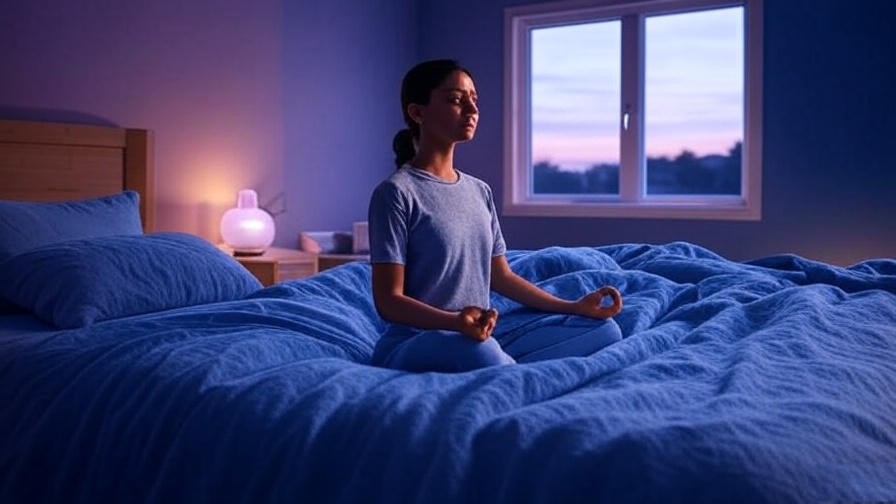Did you know that nearly 80% of people who actively engage with their dreams report improved emotional well-being and better sleep quality? Dreams are more than fleeting nighttime stories—they’re a gateway to understanding your subconscious, processing emotions, and achieving holistic wellness. Dreams wellness, the practice of harnessing dreams to enhance sleep and emotional balance, is a powerful tool for anyone seeking greater happiness and mental clarity. In this comprehensive guide, we’ll explore five proven, science-backed techniques to unlock the potential of your dreams, helping you sleep better, reduce stress, and cultivate emotional resilience. Whether you’re new to dream exploration or a seasoned practitioner, these strategies will transform your nights and enrich your days.
What is Dreams Wellness?
Defining Dreams Wellness
Dreams wellness is the intentional practice of engaging with your dreams to improve sleep quality, emotional health, and overall well-being. It combines elements of mindfulness, meditation, and sleep hygiene to create a holistic approach to mental and emotional clarity. By exploring the content of your dreams—whether through journaling, lucid dreaming, or interpretation—you can uncover subconscious insights, process unresolved emotions, and enhance the restorative power of sleep. According to a 2023 study published in the Journal of Sleep Research, individuals who regularly engage in dream-focused practices report a 25% improvement in sleep satisfaction and emotional regulation.
Why Dreams Matter for Sleep and Emotional Health
Dreams play a critical role in how our brains process emotions, consolidate memories, and cope with daily stressors. During REM (Rapid Eye Movement) sleep, when most vivid dreaming occurs, the brain sorts through experiences, helping you make sense of complex feelings. Dr. Rosalind Cartwright, a renowned sleep researcher, notes, “Dreams are the brain’s way of tidying up emotional loose ends, paving the way for better mental health.” Poor dream recall or frequent nightmares, however, can disrupt this process, leading to fragmented sleep and heightened stress. By prioritizing dreams wellness, you can restore balance and unlock deeper emotional insights.
The Science Behind Dreams Wellness
The science of dreams is rooted in the brain’s activity during REM sleep, which occurs in cycles throughout the night. Studies show that REM sleep accounts for 20–25% of total sleep and is essential for memory consolidation and emotional processing. A 2021 study in Nature Reviews Neuroscience found that individuals with consistent dream recall exhibit stronger emotional resilience and lower rates of anxiety. Furthermore, practices like lucid dreaming—where you gain awareness within a dream—have been shown to reduce nightmares and enhance creativity. Dreams wellness leverages these findings to create actionable strategies that align with holistic well-being and mindfulness practices.
The Link Between Dreams, Sleep, and Emotional Balance
How Dreams Influence Sleep Quality
The quality of your dreams directly impacts the quality of your sleep. Vivid, positive dreams often signal deep, restorative REM sleep, leaving you refreshed and energized. Conversely, fragmented dreams or nightmares can disrupt sleep cycles, leading to fatigue and irritability. A 2022 survey by the National Sleep Foundation revealed that 60% of people with poor dream recall report dissatisfaction with their sleep. By cultivating dreams wellness, you can improve dream vividness and coherence, which in turn supports deeper, more restful sleep.
Emotional Processing Through Dreams
Dreams act as a natural therapist, helping you process emotions that may be too overwhelming during waking hours. For example, dreams often revisit stressful events, allowing your brain to reframe and resolve them. Dr. Deirdre Barrett, a Harvard psychologist and dream researcher, explains, “Dreams provide a safe space to confront fears and process unresolved emotions, often leading to breakthroughs in emotional clarity.” By engaging with your dreams intentionally, you can amplify this process, reducing anxiety and fostering a sense of inner peace.
The Role of Dreams in Holistic Well-Being
Dreams wellness aligns seamlessly with holistic practices like meditation and mindfulness, which are central to achieving happiness and balance. Just as meditation helps you observe thoughts without judgment, dream exploration allows you to observe your subconscious mind. By understanding recurring dream themes or symbols, you can gain insights into your emotional state and make positive changes in your waking life. This connection makes dreams wellness a powerful addition to any holistic wellness routine.
5 Proven Techniques for Dreams Wellness
Technique 1: Keeping a Dream Journal

One of the most effective ways to begin your dreams wellness journey is by keeping a dream journal. This simple practice involves writing down your dreams immediately upon waking to improve recall and gain emotional insights. Studies show that consistent dream journaling can increase recall by up to 50% within two weeks. Here’s how to start:
- Keep a notebook or app by your bedside. Choose a dedicated journal or use a note-taking app like Evernote for convenience.
- Write down every detail you remember. Include emotions, colors, symbols, and even fragmented images.
- Review entries weekly. Look for patterns or recurring themes that may reflect unresolved emotions or stressors.
Example: Sarah, a 34-year-old teacher, struggled with anxiety that disrupted her sleep. After two weeks of dream journaling, she noticed recurring dreams about being late. Reflecting on these dreams helped her identify work-related stress and take proactive steps to manage it, leading to better sleep and emotional balance.
Pro Tip: If writing feels cumbersome, record a voice memo on your phone to capture dreams quickly upon waking.
Technique 2: Practicing Lucid Dreaming
Lucid dreaming—becoming aware that you’re dreaming while in the dream—offers a powerful way to enhance dreams wellness. It allows you to influence dream outcomes, reduce nightmares, and boost creativity. A 2020 study in Frontiers in Psychology found that lucid dreaming can decrease nightmare frequency by 30% in individuals with recurrent bad dreams. Here’s how to start:
- Perform reality checks during the day. Ask, “Am I dreaming?” and check your surroundings (e.g., try reading text or looking at your hands). This habit carries into dreams.
- Use mnemonic induction. Before bed, repeat, “Tonight, I will know I’m dreaming.”
- Keep a consistent sleep schedule. Lucid dreaming is more likely during regular REM cycles.
Caution: While lucid dreaming is generally safe, those with mental health conditions should consult a professional, as it may cause sleep disruptions in rare cases.
Example: Mark, a graphic designer, used lucid dreaming to confront recurring nightmares about falling. By practicing reality checks, he gained control in his dreams, transforming falls into flights, which reduced his nighttime anxiety and improved his sleep.
Technique 3: Pre-Sleep Visualization and Intention Setting
Setting intentions before sleep can shape your dreams and enhance their clarity. This technique, rooted in mindfulness, involves visualizing a desired dream scenario or affirming your intent to remember dreams. A 2023 study in Sleep Medicine found that intention setting increased dream recall by 20% in participants. Try this:

- Create a calming pre-sleep routine. Dim lights, avoid screens, and practice deep breathing.
- Visualize a peaceful scene. Imagine a serene beach or forest to promote positive dreams.
- Set an intention. Silently repeat, “I will remember my dreams clearly” or “I will dream peacefully.”
Example: Lisa, a busy mom, used pre-sleep visualization to reduce stress-related dreams. By imagining a tranquil lake each night, she reported fewer nightmares and more restful sleep within a week.
Pro Tip: Pair this technique with a guided meditation app like Calm to enhance relaxation and dream vividness.
Technique 4: Creating a Dream-Friendly Sleep Environment
Your sleep environment plays a pivotal role in the quality of your dreams and overall dreams wellness. A calming, optimized bedroom promotes deeper REM sleep, where vivid dreaming occurs, leading to better emotional processing and rest. According to the National Sleep Foundation, a well-designed sleep environment can improve sleep quality by up to 30%. Here’s how to create a dream-friendly space:
- Minimize blue light exposure. Avoid screens at least an hour before bed, as blue light suppresses melatonin, disrupting REM sleep.
- Maintain a cool, dark bedroom. Set the thermostat to 60–67°F (15–20°C) and use blackout curtains to enhance dream vividness.
- Incorporate calming scents. Use lavender or chamomile essential oils in a diffuser to promote relaxation and positive dreams.
- Limit caffeine and alcohol. Avoid caffeine after 2 PM and alcohol close to bedtime, as both can fragment REM sleep and reduce dream recall.
Example: James, a software developer, struggled with restless sleep and vague dreams. By using blackout curtains and a lavender diffuser, he reported deeper sleep and clearer dream recall within 10 days.
Pro Tip: Invest in a high-quality mattress and pillows to support uninterrupted sleep cycles, maximizing your time in REM.
Technique 5: Dream Interpretation for Emotional Insight
Interpreting your dreams can unlock profound insights into your subconscious, helping you address emotional challenges and enhance mental clarity. By identifying recurring symbols or themes, you can better understand your emotions and stressors. A 2022 study in Psychological Reports found that dream interpretation improved emotional self-awareness in 65% of participants. Here’s how to get started:
- Identify key symbols. Common dream symbols like water (emotions), flying (freedom), or falling (insecurity) often reflect subconscious feelings.
- Reflect on emotions. Note how you felt during the dream and upon waking, as emotions often hold the key to meaning.
- Use a dream dictionary sparingly. While guides can offer ideas, focus on personal associations with symbols for authentic insights.
- Consider professional support. For complex or recurring dreams, consult a certified dream therapist or psychologist.

Example: Emma, a college student, had recurring dreams about being chased. Through dream interpretation, she connected the dreams to feelings of overwhelm in her studies. Addressing these stressors reduced the dreams’ frequency and improved her emotional balance.
Pro Tip: Join a dream-sharing group or online forum to discuss your dreams and gain new perspectives, but prioritize interpretations that resonate with your personal experiences.
Common Challenges in Dreams Wellness and How to Overcome Them
Difficulty Remembering Dreams
For many, recalling dreams is the first hurdle in dreams wellness. Poor dream recall is often linked to inconsistent sleep schedules or lifestyle factors. To improve recall:
- Stick to a consistent sleep schedule. Go to bed and wake up at the same time daily to stabilize REM cycles.
- Reduce alcohol consumption. Alcohol suppresses REM sleep, reducing dream vividness.
- Practice mindfulness. A brief meditation before bed can enhance dream awareness.
Quick Tip: Set an alarm 10 minutes before your usual wake-up time to wake during a REM cycle, when dreams are most vivid and easier to recall.
Dealing with Nightmares
Nightmares can disrupt sleep and emotional balance, but dreams wellness offers solutions. Imagery Rehearsal Therapy (IRT), a technique where you rewrite the narrative of a nightmare, is highly effective. A 2021 study in Sleep Medicine Reviews found that IRT reduced nightmare frequency by 70% in individuals with PTSD. Try this simplified IRT exercise:
- Write down the nightmare in detail.
- Create a new, positive ending (e.g., turn a chase into a peaceful walk).
- Visualize the revised dream before bed for several nights.
Example: Maria, who experienced nightmares about drowning, used IRT to reimagine swimming confidently. After a week, her nightmares decreased, and she felt more empowered.
Balancing Dream Work with Daily Life
Dreams wellness can feel time-consuming or abstract for busy individuals. To make it practical:
- Start small. Dedicate 5 minutes each morning to journal or visualize.
- Integrate with existing routines. Pair dream journaling with your morning coffee or meditation.
- Address skepticism. Focus on measurable benefits like better sleep or reduced stress to stay motivated.
By starting with small, consistent steps, you can seamlessly incorporate dreams wellness into your life, reaping long-term benefits.
Expert Insights: What Professionals Say About Dreams Wellness
Experts in sleep science and psychology underscore the transformative power of dreams wellness. Dr. Rubin Naiman, a clinical psychologist and sleep specialist, states, “Engaging with dreams is like opening a dialogue with your subconscious—it fosters healing and self-discovery.” The International Association for the Study of Dreams emphasizes that dream work can enhance creativity, problem-solving, and emotional resilience. These insights validate the five techniques outlined, which are grounded in decades of research and clinical practice. For example, dream journaling aligns with cognitive behavioral therapy principles, while lucid dreaming draws on neuroscience findings about brain plasticity.
Practical Tips to Integrate Dreams Wellness into Your Routine

To make dreams wellness a lasting habit, try this 7-day plan:
- Day 1: Start a dream journal. Write down any dream fragments upon waking.
- Day 2: Practice a reality check (e.g., count your fingers) five times during the day.
- Day 3: Set a pre-sleep intention: “I will remember my dreams.”
- Day 4: Optimize your sleep environment with dim lighting and a calming scent.
- Day 5: Reflect on a recent dream and identify one symbol or emotion.
- Day 6: Try a 5-minute pre-sleep visualization of a peaceful scene.
- Day 7: Review your dream journal for patterns and set a new intention for the week.
Complementary Tools: Use meditation apps like Headspace for guided relaxation or sleep trackers like Fitbit to monitor REM cycles. Consider creating a printable checklist to track your progress (available as a concept for readers to design themselves). Consistency is key—small daily efforts compound into significant improvements in sleep and emotional balance.
FAQs About Dreams Wellness
Can everyone learn to remember their dreams?
Yes, most people can improve dream recall with practice. Consistent sleep schedules, reduced alcohol intake, and mindfulness techniques like journaling can boost recall within weeks.
Are lucid dreams safe for everyone?
Lucid dreaming is generally safe but may cause sleep disruptions in rare cases, particularly for those with mental health conditions. Consult a therapist if you experience distress.
How long does it take to see benefits from dreams wellness?
Many notice improved sleep or emotional clarity within 2–4 weeks of consistent practice, though results vary based on individual habits and commitment.
Can dreams wellness help with anxiety?
Yes, studies show that dream work, such as journaling or IRT, can reduce anxiety by processing subconscious emotions, leading to greater emotional balance.
Conclusion
Dreams wellness is a powerful, accessible practice that unlocks the potential of your dreams to enhance sleep quality and emotional well-being. By incorporating the five proven techniques—dream journaling, lucid dreaming, pre-sleep visualization, optimizing your sleep environment, and dream interpretation—you can transform your nights into a source of insight and healing. These strategies, grounded in science and expert insights, align with holistic practices like mindfulness and meditation, making them a natural fit for anyone seeking happiness and balance. Start your dreams wellness journey today by trying one technique tonight, and share your experiences in the comments below. By embracing your dreams, you’re taking a meaningful step toward deeper sleep, emotional clarity, and lasting happiness.













